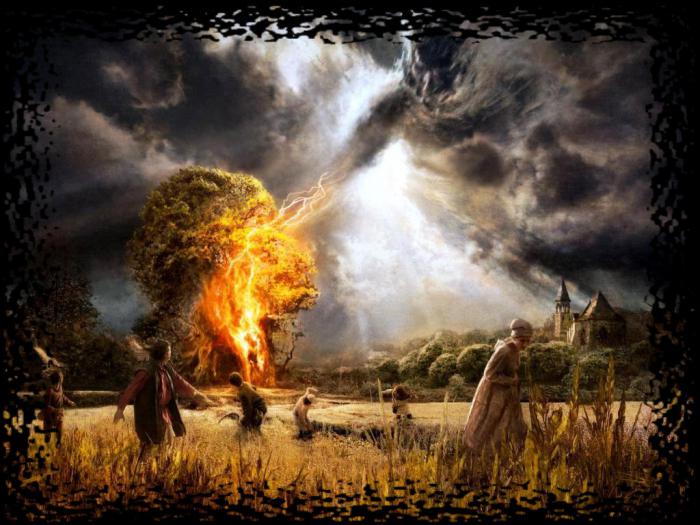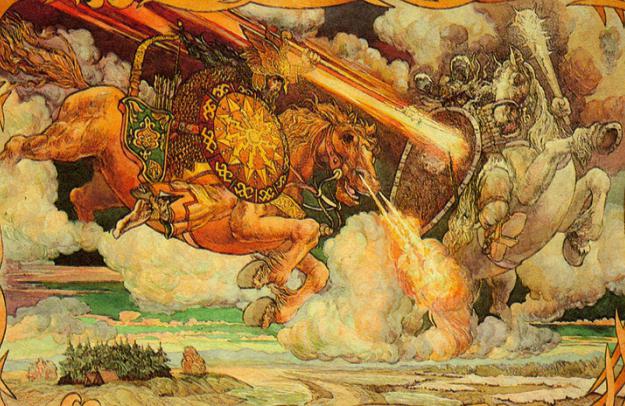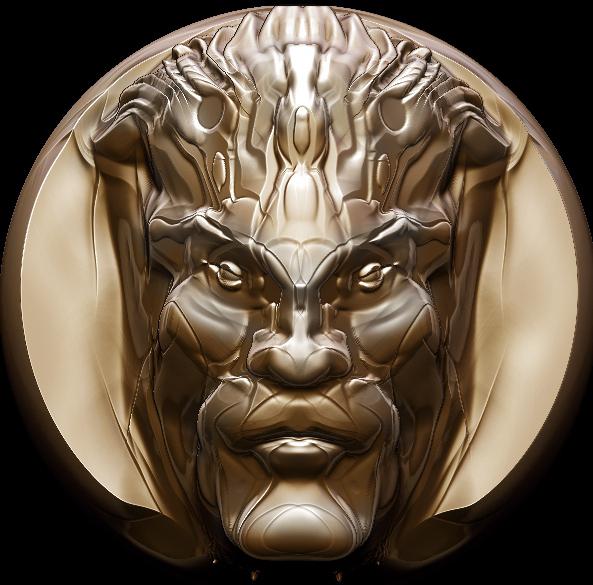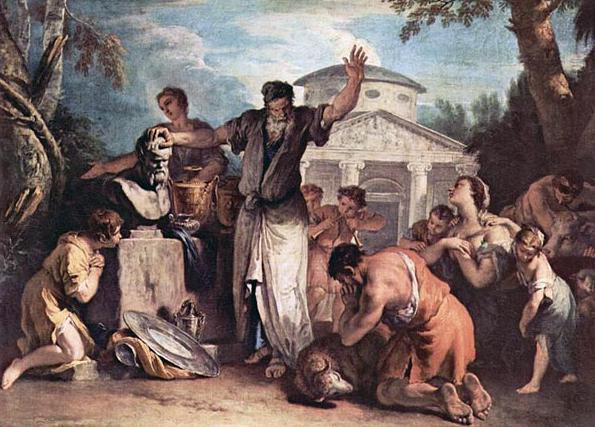Perun is the ancient Slavic god of thunder and lightning. He is the supreme ruler in the pantheon of pagan higher forces, who patronizes the prince and the fighting squad. Perun gives men power, and punishes them cruelly for non-compliance with military laws.
Birth story
According to legend, the parents of the pagan deity were not ordinary people, but higher powers. His mother, Lada, the patroness of all Russia, the supreme female deity, was in charge of family relations, procreation, love and spring. The beregin and the keeper of the hearth, she became a symbol of female beauty, but not so much physical as internal, spiritual. Father, Svarog, was a representative of celestial forces, a skilled blacksmith who forged the Earth with his own hands. It was he who became the ancestor of all the other deities worshiped by the Slavs.
The pagan god Perun was born on that rainy day, when thunderclap shook the earth, and frightening lightning pierced the vault of heaven. These forces of nature became the best lullaby for the baby: only during a thunderstorm did he sleep sweetly, did not cause unnecessary trouble. Legend has it: when little Perun grew up a bit, he ran with lightning racing and tried to shout out the thunder. But only becoming absolutely adult, he learned to control these forces of nature, to control them. Tempered by his father for work in the forge, he fell in love with the weapons that were made there. Therefore, he took on another task: to protect the valiant warriors during the battle.
Appearance
The pagan gods of the ancient Slavs were depicted in the guise that inspired fear and respect for ordinary mortals. Perun was no exception. Often he was presented as a respectable man of 35–40 years old with a golden mustache and beard, which shone like lightning. At the same time, the hair was black, with silver gray streaks of the color of a thundercloud. Like her, they swirled around his face.

God traveled across the sky in a huge chariot: the rumble of its wheels was that thunder that terrified people on Earth. The symbol of Perun is a black and white magpie, so its divine transport was harnessed not only by winged horses, but also by these birds. In addition, a thunderer could appear in front of people in different guises. For example, in the image of the formidable bull of Tour, who was considered an inviolable animal guarded by Perun. The deity was portrayed in a red cloak fluttering in the wind: this robe subsequently became the main distinguishing feature of the image of any Old Russian prince.
Iris and oak
These are the main symbols of the thunder. Like all the gods of the Slavs, Perun had its own signs, which were invariably associated with his character, aureole and activity. For example, a mighty oak. The ancient Slavs in the annals documented the rituals, of which this tree was part: usually the highest in the area, with thick branches and a dense crown. Near him, sacrifices were made in honor of Perun: they killed roosters, left pieces of meat, stuck arrows in the ground.
Another symbol of Perun is an iris of heavenly color. The blue flower was used not only in rituals associated with the deity. He was also part of the temple where the idol was placed. They made it in the form of an iris, the petals of which gradually fell to the ground and were supplemented by pits at the ends. A sacred fire burned in these depressions, and in the middle of the cup was a figurine of Perun. Another plant is dedicated to God - the color of fern. The mythical element was searched on the night of Ivan Kupala. The Slavs believed: Perun will present untold treasures to those who can overcome all the dangers and find him in the dense thickets.
Other characters
The famous sign of Perun is the so-called thunderstorm. This is a symbol similar to the sun. Six rays diverge from the center, directed in different directions. A sign was often painted above the front door of the house. People believed that it protects the native walls from evil spirits and evil eyes. For the same purpose, he was carved on shutters and roofs. Women embroidered a symbol in the form of a flower: such "towels" were given to men on a military campaign in order to protect them from enemy swords and arrows, to endow them with strength and courage. Later, this sign of Perun transformed a little and became like a wheel - one that was part of the thunders chariot.
The main weapon of God was considered an ax with wonderful power. Inserted into the
door jamb, with images of Thunder and the Sun, it also served as a talisman of human dwelling, prevented the penetration of evil forces, troubles and misfortunes. Interestingly, after the baptism of Rus, all the symbols and properties of Perun passed "by inheritance" to the prophet Elijah - the saint, who is revered by the whole Orthodox world.
Attributes
The day of the week of Perun is Thursday, during which the Slavs worshiped him and made sacrifices. Performing rituals, people asked the deity for the opportunity to change their lives for the better. Since then, it is believed that Thursday is the most successful day for changes, new beginnings. Ideally, when the moon is growing at this time : it only speeds up the steps in the right direction, contributing to the whole process.

Like other gods of the Slavs, Perun patronized the world of flora and fauna. In addition to the aforementioned oak, iris, fern, bull and magpie, wolves, boars, bay horses, as well as boletus, peas and oats were under his protection. The number of the deity is 4, metal is tin, stone is lapis lazuli, sapphire. The planet of the solar system - Jupiter, under the influence of which grow rich crops, cattle gives offspring. When the science of astrology became popular in the territory of modern Russia, Belarus, and Ukraine, it was believed that all agricultural work should be started invariably during the period during which Jupiter dominates.
Abilities
Based on the fact that Perun was a thunderer, he was able to cause severe thunderstorms. God is not only metal lightning at his pleasure: with their help, he punished people who angered him. Usually undesirable burned alive in place. Those who managed to survive were considered almost holy. The lucky ones were called "tagged Perun," because after the incident they usually opened up hidden magical powers, healers and psychic abilities.
And Perun himself - the god of thunder and lightning - was an excellent magician. He flew through the sky in a chariot, knew how to transform into different animals, birds, people. At his request, he created ghostly creatures whom he sent to mortals with a certain mission. In addition, Perun possessed tremendous physical strength; it was not without reason that it was compared to oak. By the way, the Slavs were so afraid of the Thunderer that they never chopped these trees. They revered the oak tree into which lightning struck with double ecstasy: the wands and clubs cut from its trunk were considered the best weapons not only in the battle against mortal enemies, but also with magical creatures from the afterlife of Navi.
Enemies of the deity
They were dark entities who tried to penetrate from the afterlife into the lives of people in order to harm them, to bring evil. For example, according to a long-standing legend, the lightning god Perun kills a three-headed snake, who tried to abduct his beloved Diva. In order to defeat the enemy, he even steps over his pride and joins forces with the girl’s father - his long-time opponent, the god Veles. After the overthrow of the monster, Perun is engaged to the beautiful Diva, from this union a brave Devan is born - the goddess of hunting, the wife of the patron of the forests Svyatobor.

Perun and Veles constantly competed with each other: either they could not share the herds of animals, then they proved who was stronger and more powerful. Their hostility can not be called enmity, rather it is the story of two brothers who do each other petty dirty tricks, while maintaining respect and even experiencing hidden kindred love. By the way, Veles was the god of cyclic movement. In humans, he was associated with a bear with strong magical abilities.
First feat
It was he who elevated Perun to unprecedented heights in the divine pantheon. And this is not surprising. The gods of the Slavs - Perun in particular - were not indifferent to battles and battles. The thunderer passed his baptism of fire during the battle with the ugly Scepter - half serpent, half scorpion. Having overthrown him, he earned the respect of higher powers, as well as mere mortals. After this, other battles of Perun followed: he killed the children of Chernobog, the evil lord of the dark forces, defeated griffins and basilisks. For indomitable fearlessness and boundless fury, he was made the main protector of the worlds of people and gods - Reveal and Reign.

Reading old written sources, for example, the manuscript of Procopius of Caesarea, dated to the VI century, it can be assumed that Perun was considered the supreme god. The rays of his glory, he eclipsed even his father and grandfather - Svarog and Rod. And this is natural: Perun was the patron saint of combatants. And for most of its history, Russia was in a state of bloody war, and the poet of Perun appeased gifts and sacrifices regularly and generously.
Day of god Perun
Our ancient ancestors celebrated it on June 20. On this day, men cleaned their weapons - axes, axes, knives, spears - and marched with them along the main streets of the city. At the same time, the soldiers sang ritual songs that glorified the deity. In a kind of parade, they reached the edge of the forest, where a temple was built - a place in which sacrifices were made. Having slaughtered a rooster or a bull, people sprinkled with their blood the armor and weapons they brought - it was believed that after the ritual it was blessed by God himself for a victorious war. In addition, the heads of the warriors were anointed with it in order to protect them from death in an unequal battle.
When the ritual ended, the soldiers returned to the city, where staged battles of Veles and Perun took place on the main square, of which the latter invariably emerged victorious. A lot of gifts were prepared for the deity, which were stacked in a boat and set on fire. The ashes were buried, after which they sat down at the festive table. The priests advised the soldiers to spend this night with women, since they should be victors not only on the battlefield. Also on Perunov day, people caused rain: they poured water on the chosen girl so that their summer drought would not destroy their harvest.
Serving Perun
This process was called sorcery, or fattening. To perform rituals and ceremonies could only specially trained people who were prophesied this role from birth. They were called accordingly: the wise men or priests. Some chronicles state that princes or other high-ranking persons often played their role. The honorary caste also included boys to whom this title passed by inheritance, as well as young men gifted with unusual abilities.

The pagan gods of the ancient Slavs always had a high priest, who was the connecting link between the higher powers and the people. This also applies to Perun. The other priests served the High Priest, who are on this hierarchical staircase a notch. Their duties included maintaining a sacrificial fire in pagan temples, organizing and conducting sacrificial rites, walking through villages and talking about the power of a deity. Priests often turned to people for help. They brought gifts and asked the magician to put in a word for them in front of Perun: to heal from wounds received in battle, to endow invulnerability to enemy arrows, to make a born baby courageous and strong.
In the sunset of the pagan era
The Thunderer was especially honored at this time. In each house hung a charm of Perun in the form of a small hatchet or rotor. Even Prince Vladimir, before christening Russia, ordered the installation of a huge idol depicting a deity in the very center of Kiev, not far from the princely chambers. Later, when he adopted the new faith and began to spread Christianity in all Russian lands, he ordered the idol to be thrown into the river. People who were brought up on pagan traditions ran for a long time along the shore and shouted after a floating statue: "Father Perun, blow it!" ("blow out" meant swim out).
Years later, on the very spot where the waves threw the idol onto the land, they built the Vyduby Monastery, which still exists today. Also today, the fashion for ancient traditions has returned. Scientists have found the so-called Santi Perun - a book that allegedly sets out the basic teachings of God, his laws and commandments. Although some researchers doubt the reliability of the find. They say that this is an analogue of the Indian and Aryan Vedas, only redone and veiled. Although the source is more informative, moreover, its true origin has long been proven.
Perun Ilya
As already mentioned, after the baptism of Russian lands, the gods of the Slavs were transformed into other higher forces. Perun, for example, is an analogue of the prophet Elijah. In lamentations, he was called "thunder", as he is considered the steward of the thunderous forces of nature. The main reason for this confusion is described in the biblical story: through the prayer of a prophet from heaven, fire fell on the ground and burned the enemy, also with its help the water sprinkled the dried fields and saved the harvest. In the minds of ordinary people in our time, Ilya is considered a more pagan deity than a saint from the Orthodox religion.
When a thunderstorm comes, people say that he is riding his heavenly chariot. During the harvest, they always leave a few ears of wheat - Ilya on his beard. This is also something like ancient sacrifices. It can be concluded: no matter how hard we try, pagan traditions, rites and rituals continue to exist in our daily lives. The memory of them is transmitted through the genes from generation to generation. Recently, young people have been united in groups: by joint efforts they revive Slavic rites, including those that glorify the mighty and courageous Perun.